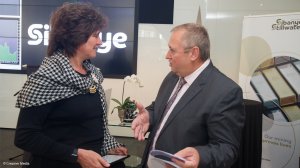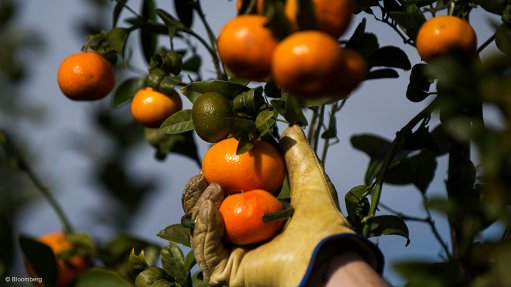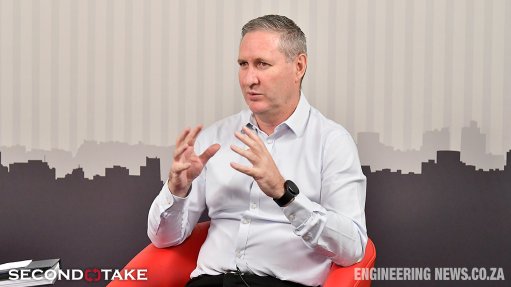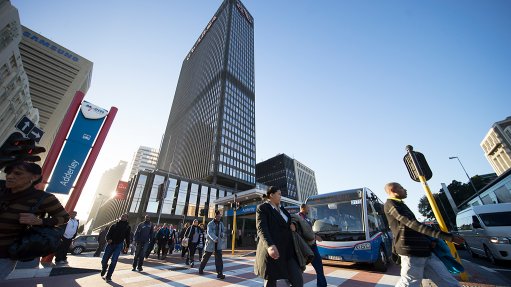Unnurtured mining industry will disappear – Sibanye-Stillwater


Sibanye-Stillwater CEO Neal Froneman at company rebranding covered by Mining Weekly Online’s Martin Creamer. Photographs: Duane Daws. Video and Video Editing: Darlene Creamer.
JSE CEO Nicky Newton-King and Sibanye-Stillwater CEO Neal Froneman.
Photo by Duane Daws
JOHANNESBURG (miningweekly.com) – An unnurtured South African mining industry will disappear, Sibanye-Stillwater CEO Neal Froneman warned on Wednesday, when he slated the regulator for allowing illegal mining activity to spiral out of control and for causing equity risk and the cost of capital to rise, placing mining companies at a huge competitive disadvantage.
The rebranded Sibanye-Stillwater recorded a net loss of $363.8-million in the six months to June 30, causing it to step back from the declaration of dividends against a background of being a substantial dividend payer since its inception four years ago. (Also watch attached Creamer Media video).
“Unless we nurture the South African mining industry, it will disappear,” Froneman warned at a function preceding the company’s presentation of results, which saw group operating profit of R3.2-billion impacted by lower gold production for the period.
Following its unbundling from Gold Fields, the then Sibanye Gold listed on the Johannesburg Stock Exchange (JSE) in February 2013 with a share price of just over R13 a share and a market capitalisation of close to R10-billion, JSE CEO Nicky Newton-King recalled at the function marking the company’s new Sibanye-Stillwater branding.
Today the share price is just under R21 a share and the market capitalisation R46.5-billion, “a really proper showing” in an area of the South African economy “not exactly the recipient of favourable policy”.
At the rebranding, Froneman made the point that a single mining industry stakeholder could not be expected to carry the full weight of the industry. "We're only one of the stakeholders. A number of stakeholders are completely selfish. They further their own interests.
“I hope that, looking forward, the selfishness will change. We, as a company, will certainly play our role in trying to improve the current situation in the mining sector in South Africa,” he told those attending the company’s rebranding to Sibanye-Stillwater.
The rebranding follows the acquisition by Sibanye of Stillwater Mining Company of the US, a high-grade, low-cost producer of platinum-group metals and the world's only primary producer of palladium.
Questioned by Mining Weekly Online, Froneman said world-class policies and standards were applied at Stillwater, “a pristine part of the world", yet a place where mining flourishes commercially and environmentally, with communities also important stakeholders.
Stillwater, he said, is also providing the company with a base from which to grow further in the North American region.
At the other extreme was the regulatory framework in South Africa, which the mining industry as a whole was not prepared to accept owing to the proposed regulations being contrary to the long-term interests of the people of South Africa.
“We know our rights, we do have a good Constitution, we’ve got a good legal system and, as you would have noticed, the Chamber of Mines has been very successful in opposing some of these nonsensical suggestions.
“We will, of course, do our own thing if necessary, but for now we’re right behind the chamber,” he commented to Mining Weekly Online.
As a result of the lack of support, equity risk for mining companies has risen, as has the cost of capital, which puts us at a huge disadvantage from a competitiveness point of view.
Froneman expressed the hope that all stakeholders would come together and resolve matters owing to the important part that mining plays in uplifting communities, employees, the environment and shareholders.
In response to Standard Bank mining analyst Adrian Hammond he decried the limited way in which the regulator had engaged with the Chamber of Mines on Mining Charter Three and condemned this as being “clearly unacceptable”.
He described the proposals of the revised charter as being “ludicrous, unacceptable and unconstitutional, and quite honestly, we won’t accept them”.
Owing to the regulator playing its cards “in exactly the wrong way” after the chamber held back on its declaratory order, the industry has ended up with legal leverage.
“And it is real leverage, and those court cases will proceed,” Froneman said, adding that the chamber had been very successful in obtaining a court interdict and staving off the attempted imposition of a moratorium on the transfer of mining licences.
“It’s not a sustainable environment to carry on like that, but at this point it is the only language that is understood by our regulator,” he told investors, analysts and journalists at the company’s presentation of half-year results, attended by Creamer Media’s Mining Weekly Online.
What the industry needed to do was to continue to work with all stakeholders to change the current environment, which was clearly not conducive to investment.
“I’m deeply despondent with what’s happened, but we’ll play our role in changing it,” he said.
Currently, the jobs of 7 400 employees of the Sibanye-Stillwater gold operation at Cooke and Beatrix West are the subject of a Section 189 process dealing with job scrutiny.
The employees under Section 189 represent 10% of the total 72 000 workforce, with the overhead structure also heading for restructure.
ILLEGAL MINING
Froneman condemned illegal mining as being out of control and expressed grave concern at the regulator failing to draw a clear distinction between illegal infiltration into existing operations by illegal miners working hand-in-glove with employees, and the illegal mining of abandoned mines, for which artisanal mining status was under consideration.
“You can put the smartest systems you can think of in place and if there is collusion with employees, infiltrators will get around these systems and infiltrate the operations,” he said.
The company had arrested 665 illegal miners at the Cooke section, along with 123 employees, who had been suspended for aiding and abetting illegal infiltration.
Froneman was insistent that the company was unable to deal with the illegal mining issue on its own.
Stopping mining at Cooke and Beatrix West will result in a decline of 220 554 oz of gold in 2018.
Sibanye-Stillwater CFO Charl Keyter said in response to RMB Morgan Stanley research head and equity analyst Chris Nicholson that the closure cost of Cooke and Beatrix West was conservatively estimated at about R1-billion, depending on the number of retrenchments arising out of the Section 189 process.
Froneman said in response to a private investor that Sibanye-Stillwater was striving to lessen its dependence on State power utility Eskom, which he described as “an inefficient organisation”.
Sibanye-Stillwater is currently Eskom’s second-largest client: “Until Eskom demonstrates their ability to run a business properly, we can’t just be totally dependent on Eskom, hence some of the other initiatives we’ve got around solar power,” he said.
On the issue of negotiating with Eskom for a lower tariff owing to the electricity surplus, Froneman said that while Eskom had opened the door to such discussions, it would mean Sibanye-Stillwater having to consume more power to get the better rates, which went against the steps being taken to build the Sibanye-Stillwater business around less power consumption.
“It’s a bit of a Catch 22, but we’re not the Red Cross,” he quipped.
Meanwhile, Bloomberg reports that Sibanye-Stillwater is focusing on reducing borrowings after its $2.2-billion purchase of US Stillwater, making the payment of a cash dividend “inappropriate” at this stage.
The first-half net loss of $363.8-million includes a large impairment charge on unprofitable mines it plans to close and a provision for settling a lung-disease class-action lawsuit.
Sibanye, which is the second-best performing member of a Bloomberg Intelligence index of global producers over the past four years, still expects to generate positive cash flow in 2017, it said Wednesday. In the absence of a dividend, it plans to give investors two new shares for every 100 held.
The company has gained 24% this year as gold strengthened, and has more than tripled in the past four years.
With production at its core South African mines expected to fall by half by 2030 as reserves are depleted, Froneman led a move into platinum, first by buying mines from Anglo American Platinum and later Stillwater.
Most of Sibanye’s debt has been incurred in these acquisitions. The company had net borrowings of $1.7-billion at June 30. Net debt is currently 2.6 times earnings and will increase towards three times next year.
Sibanye-Stillwater is one of 44 mining companies listed and the seventieth-largest company on the JSE, trading R180-million a day on 3 900 trades.
“That’s a substantial contribution to our bourse’s activity every day,” said Newton-King, who praised Froneman’s “formidable positivity”.
Sibanye-Stillwater now ranks as the third-largest producer of palladium and platinum and also as one of the top-ten gold companies.
Comments
Press Office
Announcements
What's On
Subscribe to improve your user experience...
Option 1 (equivalent of R125 a month):
Receive a weekly copy of Creamer Media's Engineering News & Mining Weekly magazine
(print copy for those in South Africa and e-magazine for those outside of South Africa)
Receive daily email newsletters
Access to full search results
Access archive of magazine back copies
Access to Projects in Progress
Access to ONE Research Report of your choice in PDF format
Option 2 (equivalent of R375 a month):
All benefits from Option 1
PLUS
Access to Creamer Media's Research Channel Africa for ALL Research Reports, in PDF format, on various industrial and mining sectors
including Electricity; Water; Energy Transition; Hydrogen; Roads, Rail and Ports; Coal; Gold; Platinum; Battery Metals; etc.
Already a subscriber?
Forgotten your password?
Receive weekly copy of Creamer Media's Engineering News & Mining Weekly magazine (print copy for those in South Africa and e-magazine for those outside of South Africa)
➕
Recieve daily email newsletters
➕
Access to full search results
➕
Access archive of magazine back copies
➕
Access to Projects in Progress
➕
Access to ONE Research Report of your choice in PDF format
RESEARCH CHANNEL AFRICA
R4500 (equivalent of R375 a month)
SUBSCRIBEAll benefits from Option 1
➕
Access to Creamer Media's Research Channel Africa for ALL Research Reports on various industrial and mining sectors, in PDF format, including on:
Electricity
➕
Water
➕
Energy Transition
➕
Hydrogen
➕
Roads, Rail and Ports
➕
Coal
➕
Gold
➕
Platinum
➕
Battery Metals
➕
etc.
Receive all benefits from Option 1 or Option 2 delivered to numerous people at your company
➕
Multiple User names and Passwords for simultaneous log-ins
➕
Intranet integration access to all in your organisation




















